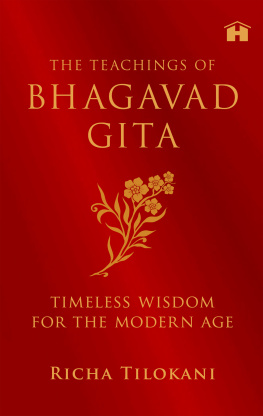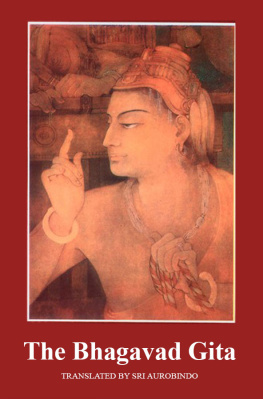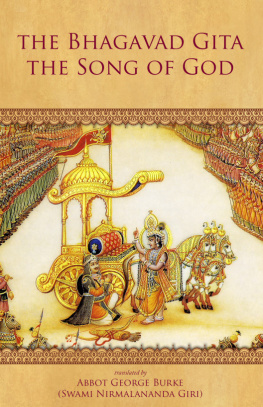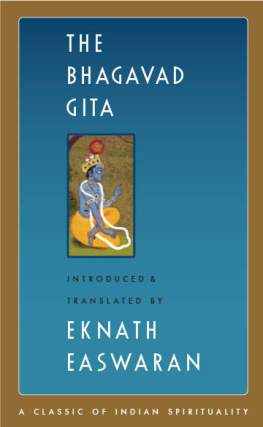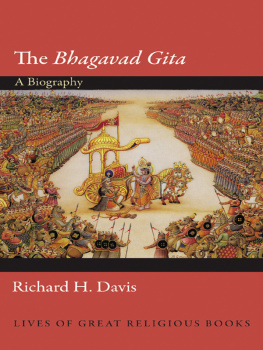
THE BHAGAVAD GITA
ADVISORY EDITOR: BETTY RADICE
JUAN MASCAR was born in Majorca. The beauty of the island, then unspoilt, and the strength of the living folk tradition, made a deep impression on him as a child. At the age of thirteen he copied a book on occultism, but this proved spiritually misleading. However, he found a reading of the Bhagavad Gita highly illuminating, although it was a poor translation, and this led him to study the elements of Sanskrit. Later he went to Cambridge, where he read modern and oriental languages, Sanskrit, Pali and English.
He lectured in Oxford on the Spanish mystics, and then went to Ceylon, where he was Vice-Principal of Parameshvara College at Jaffna, and to the University of Barcelona, where he was Professor of English. After the Spanish Civil War he settled permanently in England. He lived at first on the hills above Tintern Abbey; he translated some Upanishads (also a Penguin Classic) and the Bhagavad Gita. He then returned to Cambridge University where he was a supervisor in English and lectured on Literary and Spiritual Values in the Authorized Version of the Bible. He also translated the Dhammapada from Pali for the Penguin Classics. He married Miss Kathleen Ellis in 1951 and they had a son and a daughter. Juan Mascar died in 1987. The Times obituary described him as a man who had achieved the unique feat of translation from languages not his own (Sanskrit and Pali) into another language not at first his own (English). His aim decried by some academic critics but appreciated by thousands of readers all over the world was to convey the essence of the original in pure, poetic English His translations of the Gita, Upanishads and Dhammapada are the best that we have in English, and are unlikely to be superseded.
SIMON PEARSE BRODBECK was born in 1970 in Lancaster and grew up in the Lune Valley. After attending the local comprehensive school, he studied at the universities of Cambridge and London, completing his PhD thesis, Action without attachment in the Bhagavad Gita, at the School of Oriental and African Studies. He is currently teaching part-time and pursuing further research on the Mahabharata. He is married and his interests include philosophy, gender studies, cricket and gardening.
THE BHAGAVAD GITA
Translated from the Sanskrit by
JUAN MASCAR
With an introduction by
SIMON BRODBECK
PENGUIN BOOKS
PENGUIN BOOKS
Published by the Penguin Group
Penguin Books Ltd, 80 Strand, London WC2K 0RL, England
Penguin Putnam Inc., 375 Hudson Street, New York, New York 10014, USA
Penguin Books Australia Ltd, 250 Camberwell Road, Camberwell, Victoria 3124, Australia
Penguin Books Canada Ltd, 10 Alcorn Avenue, Toronto, Ontario, Canada M4V 3B2
Penguin Books India (P) Ltd, 11 Community Centre, Panchsheel Park, New Delhi 110 017, India
Penguin Books (NZ) Ltd, Cnr Rosedale and Airborne Roads, Albany, Auckland, New Zealand
Penguin Books (South Africa) (Pty) Ltd, 24 Sturdee Avenue, Rosebank 2196, South Africa
Penguin Books Ltd, Registered Offices: 80 Strand, London WC2K 0RL, England
www.penguin.com
This translation first published 1962
Reprinted with new Chronology, Introduction and Further Reading 2003
Copyright Juan Mascar, 1962
Chronology, Introduction and Further Reading copyright Simon Brodbeck, 2003
All rights reserved
Except in the United States of America, this book is sold subject
to the condition that it shall not, by way of trade or otherwise, be lent,
re-sold, hired out, or otherwise circulated without the publishers
prior consent in any form of binding or cover other than that in
which it is published and without a similar condition including this
condition being imposed on the subsequent purchaser
EISBN: 9780141902678
CONTENTS
ACKNOWLEDGEMENTS
The translator wishes to tender grateful acknowledgements to the following for permission to quote copyright passages in his Introduction:
Methuen & Co., Publishers, Ltd, London, for quotations from the Vedas, translated by J. Mascar in his Anthology Lamps of Fire.
John Murray, Publishers, Ltd, London, for quotations from the Upanishads, translated by J. Mascar under the title Himalayas of the Soul.
J.M.
This volume is dedicated to Hugh lAnson Fausset.
CHRONOLOGY
Dating Indian texts is extremely difficult, partly because many of them were continuously compiled over long periods. The vagueness of the following scheme reflects this.
3102 BCE | traditional dating of Mahabharata war (discredited) |
25001600 BCE | peak of Indus (and Sarasvati) Valley civilization |
1500800 BCE | composition of the Vedic hymns |
c. 800 BCE | rise of iron technology in India |
800200 BCE | composition of the major Upanishads |
563483 BCE | life of the Buddha |
540468 BCE | life of Mahavira, founder of Jainism |
500 BCE 500 CE | compilation of the Mahabharata, including the Bhagavad Gita |
1785 | Bhagavad Gita first translated into English, by Charles Wilkins |
INTRODUCTION
The Bhagavad Gita is a small excerpt of the Mahabharata. The Mahabharata is the larger of the two Indian epics, the other being the Ramayana. The period of their composition, 500 BCE500 CE, was one of extreme textual proliferation. Both epics intriguingly present the kind of esoteric discourse (on various ritual, cosmological and religio-philosophical matters) prevalent amongst the Brahminical priestly-academic lite, within a framework derived from more popular storytelling traditions. Each is a story, a narrative of various characters and their adventures. Other stories are also told within the narrative, and the main characters reflect on these stories in ways which suggest how the reader might reflect on theirs. Although the Sanskrit epics were more or less fixed in their extended, digressional literary format in the early centuries of the Common Era, their stories exist in diverse versions in dramatic, bardic and literary contexts which continue to change and develop in the present day.
The Bhagavad Gita takes place at a critical point deep within the Mahabharata. Two vast armies stand mustered and almost ready to close in battle. The assembled warriors come from the length and breadth of the known world. The dispute they hope to resolve is one of kingdom and honour between rival sets of cousins, the Pandavas, sons of Pandu, and the Kauravas, sons of Dhritarashtra, Pandus blind elder brother. Though ineligible for kingship, Dhritarashtra has been regent of the realm and guardian of the crown princes after Pandus early retirement and death. He had partitioned the kingdom, but his sons had arranged a gambling match, won a thirteen-year loan of the Pandavas half, and then refused to return it, precipitating war.
Arjuna, the most distinguished warrior in the Pandava army, surveys his adversaries and expresses to Krishna, his charioteer and great friend, his resolve not to fight. The opposing forces contain many with whom the Pandavas have no quarrel: moreover, these include highly esteemed teachers and elders. Arjunas scruples centre on the imagined personal consequences of fighting: his guilt for the decimation of his people. Krishna speaks with him the


